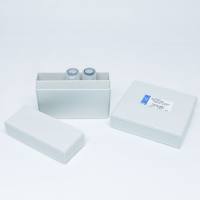Visualization of Live Primary Cilia Dynamics Using Fluorescence Microscopy
互联网
- Abstract
- Table of Contents
- Materials
- Figures
- Videos
- Literature Cited
Abstract
Methods useful for exploring the formation and functions of primary cilia in living cells are described here. First, multiple protocols for visualizing solitary cilia that extend away from the cell body are described. Primary cilia collect, synthesize, and transmit information about the extracellular space into the cell body to promote critical cellular responses. Problems with cilia formation or function can lead to dramatic changes in cell physiology. These methods can be used to assess cilia formation and length, the location of the cilium relative to other cellular structures, and localization of specific proteins to the cilium. The subsequent protocols describe how to quantify movement of fluorescent molecules within the cilium using kymographs, photobleaching, and photoconversion. The microtubules that form the structural scaffold of the cilium are also critical avenues for kinesin and dynein?mediated movement of proteins within the cilium. Assessing intraflagellar dynamics can provide insight into mechanisms of ciliary?mediated signal perception and transmission. Curr. Protoc. Cell Biol. 57:4.26.1?4.26.22. © 2012 by John Wiley & Sons, Inc.
Keywords: primary cilium; cilia; intraflagellar transport; kymograph
Table of Contents
- Introduction
- Basic Protocol 1: Imaging Fluorescent Proteins in Live, Filter‐Grown, MDCK Cell Primary Cilia
- Basic Protocol 2: Imaging Fluorescent Proteins in Primary Cilia of Live NIH3T3 Cells
- Staining Ciliary Proteins or Ciliary Membranes with Exogenously Added Dyes
- Alternate Protocol 1: Staining Primary Cilia with Fluorescently Labeled Lipids
- Alternate Protocol 2: Staining Primary Cilia with BODIPY Cholesterol
- Alternate Protocol 3: Lectin Staining of Primary Cilia
- Basic Protocol 3: Visualizing and Quantifying Movement within Primary Cilia
- Alternate Protocol 4: Improved Discrimination of Protein Movement Using Cilia Photobleaching
- Alternate Protocol 5: Assessing Movement of Select Pools of Cilia Proteins Using Photoconversion
- Reagents and Solutions
- Commentary
- Literature Cited
- Figures
- Tables
Materials
Basic Protocol 1: Imaging Fluorescent Proteins in Live, Filter‐Grown, MDCK Cell Primary Cilia
Materials
Basic Protocol 2: Imaging Fluorescent Proteins in Primary Cilia of Live NIH3T3 Cells
Materials
Alternate Protocol 1: Staining Primary Cilia with Fluorescently Labeled Lipids
Materials
Alternate Protocol 2: Staining Primary Cilia with BODIPY Cholesterol
Materials
Alternate Protocol 3: Lectin Staining of Primary Cilia
Materials
Basic Protocol 3: Visualizing and Quantifying Movement within Primary Cilia
Materials
Alternate Protocol 4: Improved Discrimination of Protein Movement Using Cilia Photobleaching
Materials
Alternate Protocol 5: Assessing Movement of Select Pools of Cilia Proteins Using Photoconversion
Materials
|
Figures
-

Figure 4.26.1 Multiple fluorescent labels can be used to visualize primary cilia. (A and B ) MDCK cells stably expressing tubulinGFP. Without confocal imaging, the signal in the cilium can be swamped out by the cellular pool of tubulinGFP. A shows a side view of the cell (an x ‐ z slice). B shows a y ‐axis maximum intensity projection of a field of cells. (C ) The enrichment of SmoYFP in MDCK cilia is clear in this z ‐axis maximum intensity projection. (D ) An NIH3T3 cell expressing SmoYFP. In the top panel (this z ‐axis maximum intensity projection), the cilium appears to be a dot, but in the lower panel (an x ‐ z slice), it is clear that the cilium projects out of the cell. Levels were adjusted in D to make the cilium clearer. Scale bars = 5 µm. View Image -

Figure 4.26.2 Exogenously added fluorescent dyes can be used to visualize primary cilia. (A ) x ‐axis maximum intensity projection of MDCK cells stained with DOPE rhodamine. (B ) z ‐axis maximum intensity projection of NIH3T3 cells expressing inversinTdTomato (red) stained with BODIPY cholesterol (green). (C ) MDCK cell expressing tubulinGFP labeled with WGA rhodamine ( z ‐axis maximum intensity projection). Scale bars = 5 µm. View Image -

Figure 4.26.3 Generation of a kymograph to quantify cilia movement. After collecting a time series, a kymograph can be used to calculate the velocity of particle movements. This figure provides an overview of the steps required to generate a kymograph. Scale bars = 2 µm. View Image -

Figure 4.26.4 Using photobleaching and photoconversion to highlight moving proteins within the cilium. (A ) Kymographs generated from a time series where a region of a polaris‐GFP expressing cilium was photobleached during acquisition. The raw data was analyzed, and then processed with a walking average or median filter. Lines used for measurements are visible in the far right kymograph. (B ) SmoEos in the cilium of an MDCK cell was imaged with both 488‐ and 561‐nm light and then photoconverted. The movement of photoconverted particles is evident in the right panel (561 nm). View Image
Videos
-
 Movement within the cilium0:30Play Video
Movement within the cilium0:30Play Video -
 Photoconversion highlights small pools of proteins0:23Play Video
Photoconversion highlights small pools of proteins0:23Play Video
Literature Cited
| Berbari, N.F., Bishop, G.A., Askwith, C.C, Lewis, J.S, and Mykytyn, K. 2007. Hippocampal neurons possess primary cilia in culture. J. Neurosci. Res. 85:1095‐1100. | |
| Bloodgood, R.A. 2009. From central to rudimentary to primary: The history of an underappreciated organelle whose time has come. The primary cilium. Methods Cell Biol. 94:3‐52. | |
| Caspary, T., Larkins, C.E., and Anderson, K.V. 2007. The graded response to Sonic Hedgehog depends on cilia architecture. Dev. Cell 12:767‐778. | |
| Corbit, K.C., Aanstad, P., Singla, V., Norman, A.R., Stainier, D.Y., and Reiter, J.F. 2005. Vertebrate smoothened functions at the primary cilium. Nature 437:1018‐1021. | |
| Cuevas, P. and Gutierrez Diaz, J.A. 1985. Absence of filipin‐sterol complexes from the ciliary necklace of ependymal cells. Anat. Embryol. 172:97‐99. | |
| Follit, J.A., Tuft, R.A., Fogarty, K.E., and Pazour, G.J. 2006. The intraflagellar transport protein IFT20 is associated with the Golgi complex and is required for cilia assembly. Mol. Biol. Cell 17:3781‐3792. | |
| Goetz, S.C. and Anderson, K.V. 2010. The primary cilium: A signalling centre during vertebrate development. Nat. Rev. Genet. 11:331‐344. | |
| Handel, M., Schulz, S., Stanarius, A., Schreff, M., Erdtmann‐Vourliotis, M., Schmidt, H., Wolf, G., and Hollt, V. 1999. Selective targeting of somatostatin receptor 3 to neuronal cilia. Neuroscience 89:909‐926. | |
| Haycraft, C.J., Banizs, B., Aydin‐Son, Y., Zhang, Q., Michaud, E.J., and Yoder, B.K. 2005. Gli2 and Gli3 localize to cilia and require the intraflagellar transport protein polaris for processing and function. PLoS Genet. 1:e53. | |
| Holtta‐Vuori, M., Uronen, R.L., Repakova, J., Salonen, E., Vattulainen, I., Panula, P., Li, Z., Bittman, R., and Ikonen, E. 2008. BODIPY‐cholesterol: A new tool to visualize sterol trafficking in living cells and organisms. Traffic 9:1839‐1849. | |
| Kozminski, K.G., Johnson, K.A., Forscher, P., and Rosenbaum, J.L. 1993. A motility in the eukaryotic flagellum unrelated to flagellar beating. Proc. Natl. Acad. Sci. U.S.A. 90:5519‐5523. | |
| Leppimaki, P., Mattinen, J., and Slotte, J.P. 2000. Sterol‐induced upregulation of phosphatidylcholine synthesis in cultured fibroblasts is affected by the double‐bond position in the sterol tetracyclic ring structure. Eur. J. Biochem. 267:6385‐6394. | |
| Morgan, D., Eley, L., Sayer, J., Strachan, T., Yates, L.M, Craighead, A.S, and Goodship, J.A. 2002. Expression analyses and interaction with the anaphase promoting complex protein Apc2 suggest a role for inversin in primary cilia and involvement in the cell cycle. Hum. Mol. Genet. 11:3345‐3350. | |
| Nachury, M.V., Loktev, A.V., Zhang, Q., Westlake, C.J., Peranen, J., Merdes, A., Slusarski, D.C., Scheller, R.H., Bazan, J.F, Sheffield, V.C, and Jackson, P.K. 2007. A core complex of BBS proteins cooperates with the GTPase Rab8 to promote ciliary membrane biogenesis. Cell 129:1201‐1213. | |
| Ott, C.M., Elia, N., Jeong, S.Y., Insinna, C., Sengupta, P., and Lippincott‐Schwartz, J. 2012. Primary cilia utilize glycoprotein‐dependent adhesion mechanisms to stabilize long‐lasting cilia‐cilia contacts. Cilia 1:3. | |
| Pedersen, L.B. and Rosenbaum, J.L. 2008. Intraflagellar transport (IFT) role in ciliary assembly, resorption and signalling. Curr. Top. Dev. Biol. 85:23‐61. | |
| Praetorius, H.A. and Spring, K.R. 2001. Bending the MDCK cell primary cilium increases intracellular calcium. J. Membr. Biol. 184:71‐79. | |
| Praetorius, H.A. and Spring, K.R. 2003. Removal of the MDCK cell primary cilium abolishes flow sensing. J. Membr. Biol. 191:69‐76. | |
| Praetorius, H.A., Frokiaer, J., Nielsen, S., and Spring, K.R. 2003. Bending the primary cilium opens Ca2+‐sensitive intermediate‐conductance K+ channels in MDCK cells. J. Membr. Biol. 191:193‐200. | |
| Praetorius, H.A., Praetorius, J., Nielsen, S., Frokiaer, J., and Spring, K.R. 2004. Beta1‐integrins in the primary cilium of MDCK cells potentiate fibronectin‐induced Ca2+ signaling. Am. J. Physiol. Renal. Physiol. 287:F969‐F978. | |
| Schneider, L., Clement, C.A., Teilmann, S.C., Pazour, G.J., Hoffmann, E.K, Satir, P., and Christensen, S.T. 2005. PDGFRalphaalpha signaling is regulated through the primary cilium in fibroblasts. Curr. Biol. 15:1861‐1866. | |
| Sfakianos, J., Togawa, A., Maday, S., Hull, M., Pypaert, M., Cantley, L., Toomre, D., and Mellman, I. 2007. Par3 functions in the biogenesis of the primary cilium in polarized epithelial cells. J. Cell Biol. 179:1133‐1140. | |
| Sharma, N., Berbari, N.F., and Yoder, B.K. 2008. Ciliary dysfunction in developmental abnormalities and diseases. Curr. Top. Dev. Biol. 85:371‐427. | |
| Smith, C.L. 2008. Basic confocal microscopy. Curr. Protoc. Mol. Biol. 81:14.11.1‐14.11.18. | |
| Snow, J.J., Ou, G., Gunnarson, A.L., Walker, M.R., Zhou, H.M, Brust‐Mascher, I., and Scholey, J.M. 2004. Two anterograde intraflagellar transport motors cooperate to build sensory cilia on C. elegans neurons. Nat. Cell Biol. 6:1109‐1113. | |
| Taipale, J., Chen, J.K., Cooper, M.K., Wang, B., Mann, R.K., Milenkovic, L., Scott, M.P., and Beachy, P.A. 2000. Effects of oncogenic mutations in Smoothened and Patched can be reversed by cyclopamine. Nature 406:1005‐1009. | |
| Taschner, M., Bhogaraju, S., and Lorentzen, E. 2011. Architecture and function of IFT complex proteins in ciliogenesis. Differentiation 83:S12‐S22. | |
| Taulman, P.D., Haycraft, C.J., Balkovetz, D.F., and Yoder, B.K. 2001. Polaris, a protein involved in left‐right axis patterning, localizes to basal bodies and cilia. Mol. Biol. Cell 12:589‐599. | |
| Wakabayashi, Y., Chua, J., Larkin, J.M, Lippincott‐Schwartz, J., and Arias, I.M. 2007. Four‐dimensional imaging of filter‐grown polarized epithelial cells. Histochem. Cell Biol. 127:463‐472. | |
| Yoshimura, S., Egerer, J., Fuchs, E., Haas, A.K, and Barr, F.A. 2007. Functional dissection of Rab GTPases involved in primary cilium formation. J. Cell Biol. 178:363‐369. | |
| Internet Resources | |
| http://rsb.info.nih.gov/ij/ | |
| Image J | |
| http://www.embl.de/eamnet/html/body_kymograph.html | |
| Image J kymograph plug‐ins |









